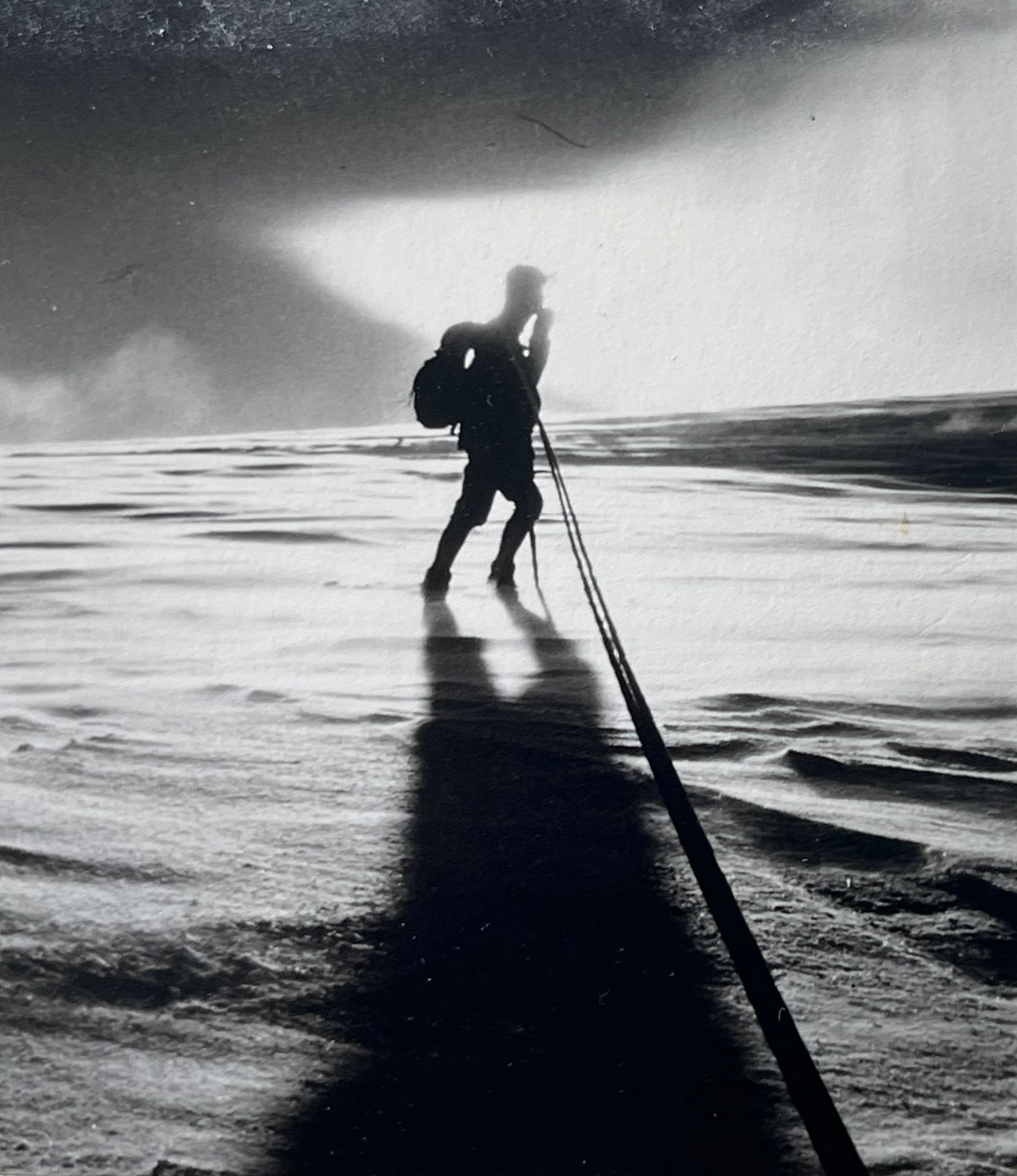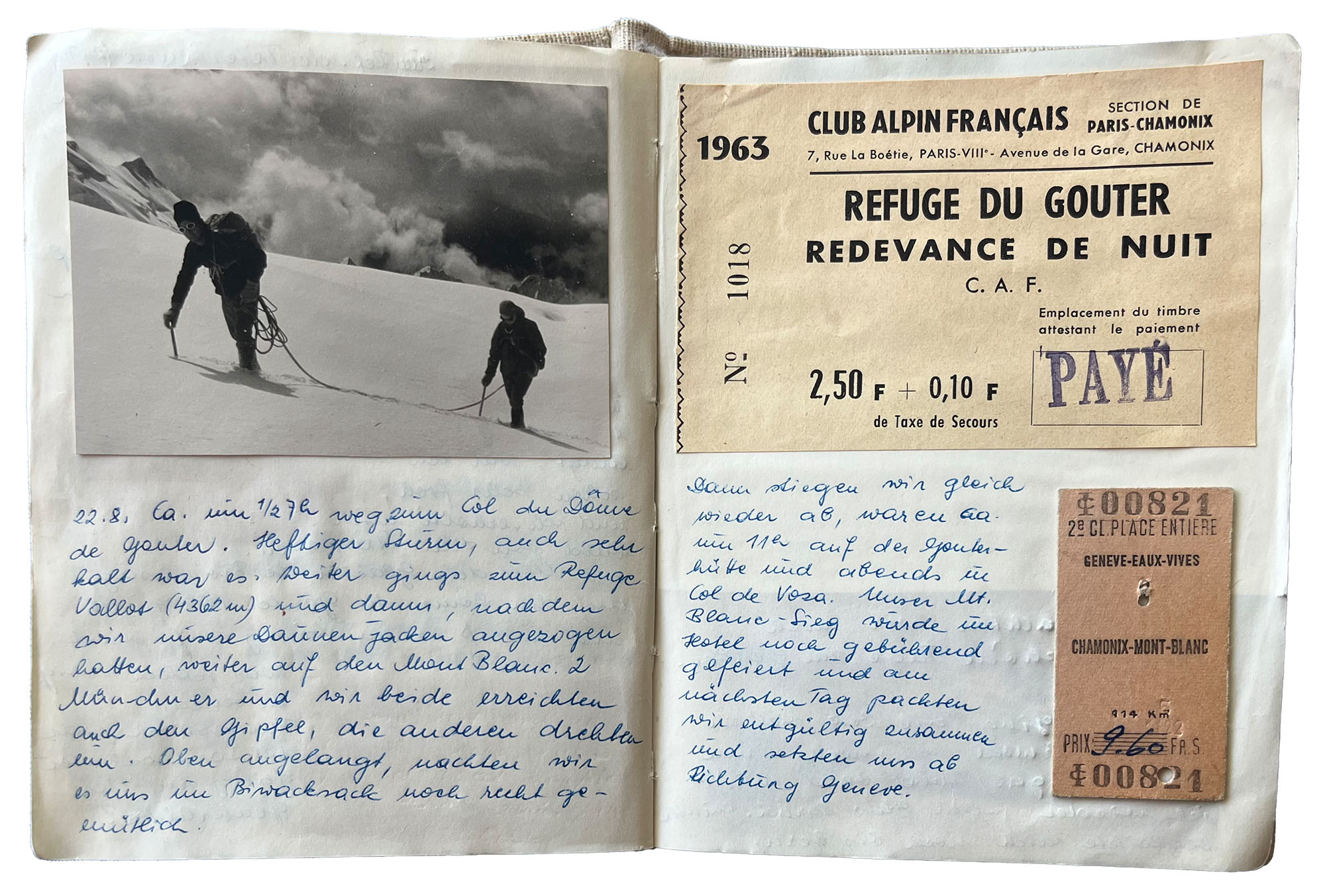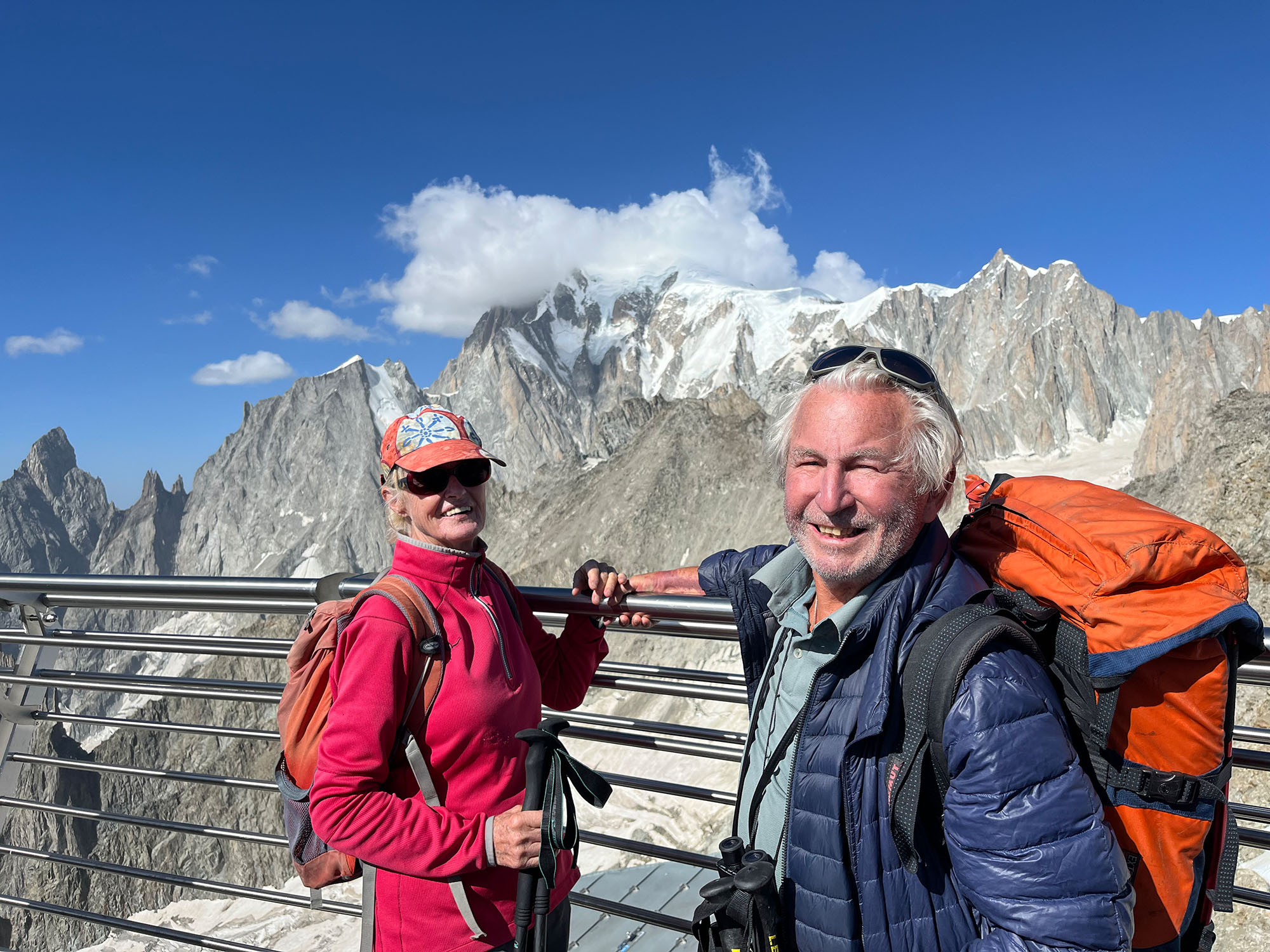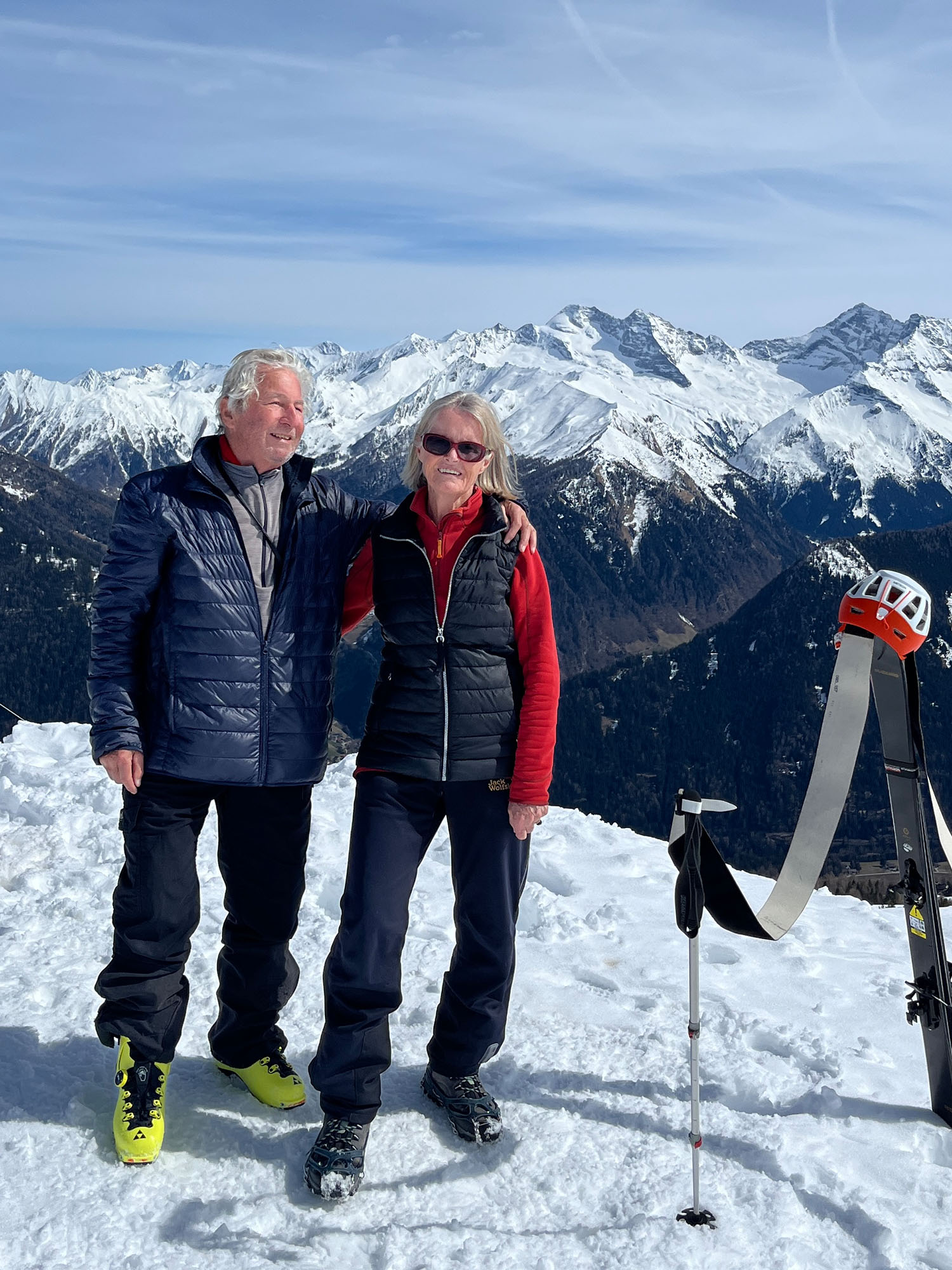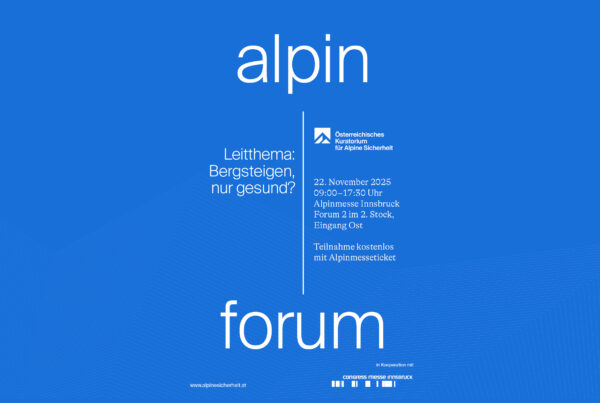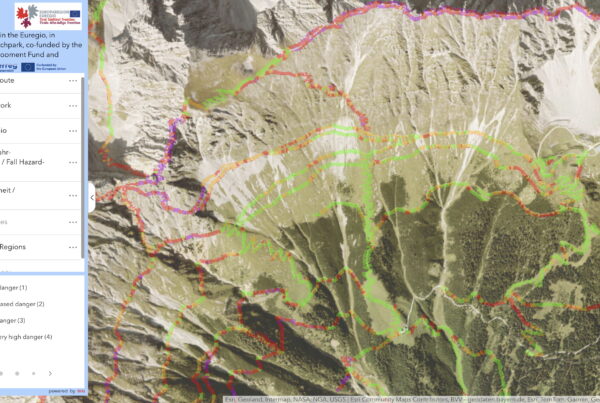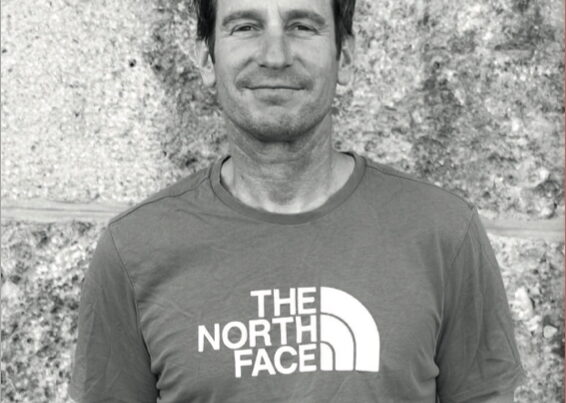This post is also available in: German Czech Polish
This interview was published in the winter 2023/24 issue of the ÖKAS trade magazine analyse:berg.
Become a subscriber to analyse:berg. You will receive the magazines conveniently delivered to your home as soon as they are published and support the work of the ÖKAS at the same time.
In memoriam Günter Auferbauer
Our obituary for Günter Auferbauer 1940 – 2025. can be found here.
Where my eye finds a foothold
Interview with Günter Auferbauer
Günter Auferbauer and his wife Luise have written around 50 books, including short guides to a number of hiking maps, and are perhaps the last authors of alpine guidebooks who write exclusively on the basis of their own empirical experience. They are also one of the few mountaineering couples who have grown old together and form a real life-long partnership, both privately and professionally.
In an interview with analyse:berg, Günter Auferbauer – a long-standing expert member of ÖKAS – provides insights into his mountaineering and professional life, tells of coincidences and youthful exuberance as well as of decisive insights that originated on a fateful day, specifically on June 30, 1963.
In conversation:
Günter Auferbauer
Author, mountaineer, ÖKAS member
Interview:
Peter Plattner
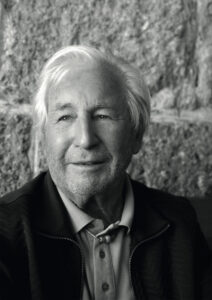
↑ Günter Auferbauer after the interview with analyse:berg
Photo: argonaut.pro
a:b
Over the last 30 years, I’ve come across your name again and again, especially as the author of countless books. Besides, I know you and your wife Luise as one of the few “mountaineering couples” and I met you personally as an ÖKAS expert member. What is your story?
GA
I am a trained typesetter and it was common practice for us, to go on the “Walz”. In this case, there was an intimate Connection to typography in Switzerland. Twice, for half a year each, I was with two professional colleagues moved to Berne and Geneva. In addition to work Our focus is naturally on mountaineering. Basically I got to know the Western Alps earlier and to a greater extent than the Eastern Alps.
The fact that I’m still sitting here at this table today is a I still have no explanation for this. The June 30, 1963 turned out to be my second birthday:
On this day, we – my two professional colleagues and I – wanted to climb the Aiguille Vertethrough the Whymper Couloir . However, in the morning on the Couvercle- I forgot my mittens in the guest basket in the hut. Only at the Couloir entrance, I realized my mishap, solved I got off the rope and walked back to the hut. My friends got in. Around 11:00 a.m. I saw them for the last time. Times: two points, uphill, rising into the fog cover. Diethard and Herwig did not return from this tour. back. Presumably as a result of the crampons being she crashed. I wish I hadn’t forgotten my mittens, I would have been the third in this rope team.
That day completely changed my life.changes. I was overwhelmed by such an intensity of life that I informed Luise: “Come to Geneva … we’re going to the Mont Blanc group for two weeks.” I’ll never forget that time: Luise arrived at 13:13 hrs. A few days later we climbed along the Dent du Requin on the SO ridge. Afterwards we braved a weather storm at the campsite in Montenvers. Our next mountain tent base for the Mont Blanc ascent was the Col de Voza. From the Tête-Rousse hut onwards were the conditions were wintry, in the Col du Dôme du Goûter the storm whipped our rope, but our wait in the Vallot was worth it. Vallot paid off: early on August 22, 1963, we reached the we reached the summit of Mont Blanc. Since this – for us memorable day – we are a “life rope team”.
Luise was already a good mountaineer back then. Our paths crossed for the first time on July 29, 1960 on the shoulder of the Matterhorn. Because of the windy The ascending three-person rope team was thickly masked due to the bad weather. It wasn’t until the evening in the “Walliser Kanne” – the classic mountaineering meeting place in Zermatt – that the situation was clarified : when I asked “Where is the third member of your rope team?”, Luise was introduced to me. A connecting The thought remained. By chance we met again the: first at the foot of the north face of the Triglav. Close at the Schöckl on New Year’s Eve 1962. We kept in touch from then on. I moved to Geneva. From the spring of 1963, a stable “letter bridge” was established. We wrote to each other regularly. Towards the summer avi I asked Luise to join me in Switzerland. Little did I know that the decisive reason would turn out to be fateful.
Sixty years later, on August 22, 2023, Luise and I returned to the beginning of our fellowship. We spent a week in the area surrounding “Chamonix-Mont-Blanc” – and found vantage points that we had never visited before, as we had always climbed to the summits.had been on the road. However, during During this – in many respects – unique “Chamonix week”,we circumnavigated half of the Mont Blanc massif . Of course, thanks to mountain railroads and cable cars.
↑ Luise climbing Mont Blanc in 1963.
Photo: Auferbauer archive
↑ Luise's tour book with the entry from August 22, 1963.
Photo: Auferbauer archive
a:b
If two friends die and you yourself only escape with your life by a stroke of luck, you might regret climbing and turn your back on it. You did the opposite and experience a new “intensity of life”. How can I understand?
GA
I can’t explain it like that. My tour book contains Black and white photos of this incident. In calligraphy I added: “Sky – clouds – mountains … our world … it gives and takes … We are never mindful of fate’s power.” Fortunately, I did not lose myself in brooding. Six weeks after the death of mycompanions, thanks to Hugo Stelzig, I was able to go on a first “compensation tour”, the Ryangrat on the Aiguille du Plan. I remember exactly how we were in the first, red morning light through rock-hard snow gullies to the start of the crag.
a:b
Do you only become an old mountaineer with a lot of luck, or do you have to contribute to it yourself?
GA
The level of personal responsibility in mountaineering is very high. I’ve been climbing mountains for around 70 years now and it took me almost as long to come up witha key phrase: “I climb with a clear consciencewhere my eyes find a foothold.” Because where my eye finds a foothold, that’s where I know I am I am allowed to move. I probably carried this maxim unconsciously in me for a long time, but have not been able to been able to formulate it.
However, I also really enjoyed mountaineering learned. I am a tour guide for mountaineering and skiing and a certified ski instructor from the BAFL (now the Federal Sports Academy, BSPA, editor’s note). The many courses were of great value, because I was able to learn get enough knowledge. All the trainers and participants The people who took part shaped – and continue to shape – me. For my life.
This had a special flair at the beginning, carried by Enthusiasm and innovation. My first climbing harness – a chest strap – I braided it myself as part of a home evening. They were happy with that for the time being. But It was soon realized that without a hip belt, the chest harness is of no use. However, it has when alpine climbing hardly any incidents, although the rope technology was different back then …
Climbing in particular has now become quite safe thanks to fixed intermediate protection and aof the stands. Many of the “Harakiri Tours” have lost their terror. And of course the climbing level. Then the bolt dis This has gone so far that drilled hookshave been sawn off dueto the fanaticism of free climbing. But this is not in the spirit of thing could be. The theories of the pure, aesthetic Climbing has claimed victims – including, for example also Paul Preuss. His theory “The ability is the Düren’s “measure” was put into perspective by his fall on the north face of the Mandlkogel : Technically, Preuss was capable of climbing the route, but a mishap or a hold breaking free, which he could not perceive from the outside , led to his death at the age of 27.
a:b
How do you explain the fact that so many climbers still pursuethis ideal today – especially many older climbers?
GA
I’m a bit shocked at how manipulativebar people are. If someone with a certain charisma and wants to see his opinion implemented , wants to be heard, that is also a certain kind of politics – the politics of self-promotion. Whether this is le is legitimate or not is for others to decide. But I think it is very dangerous to allow individual opinions to emerge so strongly and without comment. This applies to life itself and also to a certain extent to the way Preuss is sometimes celebrated today.
“We humans are captured by thoughts,
that lead to action,
of which we fundamentallyassume in principle,
that they will end well will end well.”
a:b
You have always walked “where your eye has found a foothold”. What exactly do you mean by that?
GA
The risk of falling or having an alpine accident does not increase with technical difficulty. On the contrary, the risk is often higher in “easy” terrain. higher. I’m thinking of rugged terrain, for example in difficulty ridge II to III. Today with such People whoare used to climbing gymshave more problems on the approach or descentthan on the well-secured climbing route. Unsecured walking in suchfall terrain requires “good footing”, appropriate skills and no excessive risk.
For me, it is important to be able to recognize this Step, to find this support. Only then am I sure to be able to take responsibility for what I do. Basically a principle of life.
a:b
In other words, you don’t go in blindly and let yourself be surprised, but you look ahead and have an idea of what to expect.
GA
That’s right. Such a situation is confirmed by that A guiding principle that Luise and I receivedfrom mountain and ski guide Hans Ladreiter during our research for a ski tour guide to the Schladminger Tauern : “If unfavorable chance factors are added to a considerable risk , disaster is usually inevitable.”
What a fate: a short time later, just such a coincidenceproved fatal for Hans and his accompanying mountain rescue colleagueswhile they were on a training tour on skis. The less than ideal conditions were a given. However, the group was fatally buried by an avalanche in a sparse larch forest.
What had happened? It was snowing, but the tour itself was easy to walk. However, a cornice break was not visible, this triggered an avalanche, which rushed through the loose larch stand and buried the group.
a:b
How can you explain the fact that such accidents happen even to well-trained people who also know the terrain well ?
GA
I intuitively use Werner Munter’s“Little Avalanche 1×1” as a guide: You have toassess the relevant criteriaconcerning the terrain, the conditions and, above all, yourself or the group. The question is to what extent a goal-oriented mountaineer is able to objectively assess the overall situation so that the residual risk canreally be”less than one” (then, according to Munter, it is considered “socially acceptable”, editor’snote ).At that time, however, severalunfavorable factors came together: The snow drifts close to the burr and even more so the cornice break were out of sight.
a:b
Can this necessary sensitivity be learned during training ?
GA
Training is the be-all and end-all for mountaineering in winter and summer, in all its forms. Training makes you aware of your responsibility , because you yourself are usually the greatest danger. And if you are unable to perceive an objective danger, then it becomes a subjective danger. The sense of responsibility to plan and communicate a tour has top priority, especially as you are rarely out on your own.
If you’re traveling alone, that’s a different story. thing. Walking alone is of course carried out, but ends often tragic enough. Statistics show that, for example Ski touring – also in other disciplines – accidents involving solo skiers can sometimes end fatally.
But we humans are gripped by thoughtsthoughts that lead to actions of which we are fundamentallyassume that they will go well. There are apparently an inner consistency that makes many moments, especially especially on the psychological side. Solo climber report this feeling that either tells them “it’s not right today” or gives them the certainty and joy that things will turn out well.
But this is not the “feeling of immortality” that is typical of young people. What I mean here is a snapshot for a very specific period of time and for an activity for which one is committed. mentally and physically. Also the eye finds a foothold.
a:b
If you are unsure, have doubts or a bad gut feelingfeeling, should you leave it alone?
GA
That’s exactly how it is. One of the keys to getting to the top The only way to grow old is to develop basic logical to recognize requirements. For example, the early set off on a firn tour. That’s where the training takes place, common sense and experience play a role.
On that June 30, 1963, we were ready for the planned Tour started much too late. Another rope team, two brothers, had a better idea of the situation at 5:00 a.m.the situation: too late, overcast sky, too warm, wet snow. They turned around. Still, different gray sam: 14 days later, they both died in an accident on the Dru. accident on the Dru.
↑ Luise and Günter Auferbauer 2023 in front of the Brenva side of Mont Blanc.
Photo: Auferbauer archive
a:b
The fall of your two friends was probably a classic entanglement accident. The fact that the rope provides a false sense of security here and only increases the extent of damage is shown by several entanglement accidents every year – and that for decades. Why does this change here, as with other known causes of accidents, the training little?
GA
I can’t answer that. But I was once a lay assessor at Graz Provincial Court and at every trialI asked myself why there was no one there to put their hand on the defendant’s shoulder and say said: “Leave it alone!” They have some absurd and abstract decisions are made thatare not comprehensible.
Nobody put a hand on my shoulder in 1963 either. The misfortune of having forgotten my mittens in the guest basket helped me to be lucky. Today I think that there was a higher purpose behind forgetting the mittens : namely that I should survive. I thank you for this gift by wearing the give people something personal back from me. The art, together with Luise, I have written around 50 books including short guides to maps.
a:b
How did you become an author?
GA
When I was about 30 years old, I thought weneeded to help raise awareness of the beautiful surroundings of Graz . There was Ernst von Coelln’s guidebook “100 Excursions from Graz” from the 1930s with toursup to the Hochschwab. In the meantime, transportation options had improved considerably. I thought it would be appropriate to describe the tours including travel by bus and train. I found the Styria publishing house for the realization. In addition, around 1970, the route color system was replaced by the route number system. This change was far-reaching and therefore one of the reasons for writing an excursion guide. That’s why I integrated a regionally organized trail number directorythat extended far beyond Graz and also included southern Styria.
Luise and I always wanted to give readers something pragmatic with our hiking guides. We wrote hiking guides, ski tour books and text books.illustrated volumes. The Bruckmann publishing house commissioned us with the title “Trekking in the Pyrenees”, where we will then be in the summer and winter. For this pro project, Luise and I crossed the Pyrenees for three months , following a new route along the watershed and covering around 900 kilometers and covered approx. 60,000 meters in altitude. This was by far the greatest adventure that we were able to experience together.
a:b
Is writing your main profession?
GA
Yes, for 25 years. But you can make a living from it practically not. We are in a hamster wheel, because The proceeds from one project are used to fund the next project. pre-financed. Until the funds used are returned, years pass. In fiscal terms: a zero-sum game.
“The goal is to to come home healthy again.”
a:b
How have you perceived the development of online tour portals?
GA
They are not an issue for us. We work purely empirically. Firstly, I don’t see any competition in what’s on the Internet, and secondly, I’m not tempted to look there – at most I’ll come across a reference by chance.
a:b
Have you taken every step you describe yourself?
GA
Yes, and there are a good 200,000 pictures to prove it.We also produceddozens of folders and brochures on hiking, mountaineering and cycling – i.e. outdoor sports – in connection with public transport for the Styrian Transport Association overa period of 25 years. means of transportation. Traveling by train and bus to mountain and I’ve been used to hiking tours since my youth.
a:b
For many, the car was and still is the main way to go mountaineering whether in the immediate vicinity or in the mountains. further away. When did you start working with public to travel by public transport?
GA
I was 28 years old when I got my driver’s license back then, when we became a family. Before that, I didn’t own a car. Until 1968, I traveled everywhere by train up to the Caucasus. The mountains in western Estonia in Switzerland and France, I am mainly only familiar withonly in connection with the railroads.
When it was common to travel by train in our part of the world traveling by train, there were signs in places near the valley – at relevant stations and stops – tour overview boards of the alpine clubs. Such were mountaineering, climbing, Skiing coupled with train and bus and also with hitchhiking.
There was never a problem for me to pick up my skis skis in my hand, walking to the train in my ski boots, to get to Chamonix by train, for example. to walk the Haute Route. And the same way – with skis and ski boots – we traveled from Saas-Fee via Venice back to Graz. That was contemporary travel style.
Over time, a number of train and bus connections were “rationalized away”. To the “Bodenbauer”, the most important starting point in the Hochschwab group , no bus has been running for 50 years. Trains to the Gesäuse only operate selectively. However, in more recent timesrail travel has been supplemented with bus connections.
↑ Luise and Günter in March 2024 on the Nösslachjoch in the Stubai Alps.
Photo: Auferbauer archive
a:b
So it’s all the more welcome when car-free travel to the mountainstakes center stage again?
GA
Yes, but the descriptions provided by alpine clubs for traveling by bus and train can be do not work that way. Lapidary listings are too little. First and foremost, it is important to know how home to the station. Where at the stations Travel centers are missing, detto ticket offices, are also missing relevant information. The fun word “ticket matu ra” has a serious background. Ticket machines tick not the same everywhere. Pitfalls lurk always and everywhere. “Even delays can change,” warns a popular popular female voice warns.
The fact is, you should use the public transportation system withgrow. As simple as public transport media fairly, it does not take place across modes of transportdoes not take place across all modes of transport: Changing trains is always and everywhere associated with stress.
a:b
Are there differences in Austria regarding the willingnesswillingness to travel by train?
GA Travelcard
In Vienna, the willingness is certainly high because public transport works very well, so many city dwellers do not need a GA Travelcard . need a car. Upper Austria also has a very good public transport network, including the “Traunstein cab” with its climaticket. Tirol has Austria’s best regional train type on rails. Public transport in Vorarlberg is exemplary. The For many years now, Salzburgers throughout the country have enjoyed the “Edelweiss ticket”. I call Styria a relative Motorist country. Mainly due to the infrastructure at national border areas and the non-round distribution of work. Graz alone has 100,000 commuters. So you have great pent-up demand for public transport. With the commissioning of the Koralm Railway, scheduled for September 14, 2025, Styria and Styria and Carinthia will have a new logistics platform.form. This means that the company, which has existed since 1920 missing link: freed from the peripheral location south of the Alps.
a:b
To conclude our conversation, a few short questions questions: Is mountaineering dangerous?
GA
No, if I act correctly, it’s not dangerous. From Peter Habeler there is a book with the title “Das Ziel ist the summit”. Intersubjectively, yes. However: the true goal lies about it, namely coming home healthy again.
a:b
Can mountaineering be fun?
GA
Yes, of course. I need a source in which I can regenerate. You use yourself up in the Valley landscapes, in the realm of pitfalls.Joy and satisfaction flow through me when I’m climbing.Perhaps also a little happiness when something has gonewell and when I know my feelings are shared.
a:b
What is the most important thing: the journey, the summit or the company?
GA
The accompaniment – especially for Luise. Also in the I would never have been able to write like that if she hadn’t stood by my side.
a:b
What can I wish you and Luise?
GA
We have no unpaid bills. We know how to set our goals in such a way that they realistically match our motion mode. Ultimately, we want die healthy and leave this world as close to each other as possible .
“When I’m climbing flows through me
Joy and satisfactionsatisfaction.
Perhaps also a a little happiness,
when something goes wellsucceeded
and when I my feelings shared.”
This interview was published in the winter 2023/24 issue of the ÖKAS trade magazine analyse:berg.
Become a subscriber to analyse:berg. You will receive the magazines conveniently delivered to your home as soon as they are published and support the work of ÖKAS at the same time.
Links & Publications:
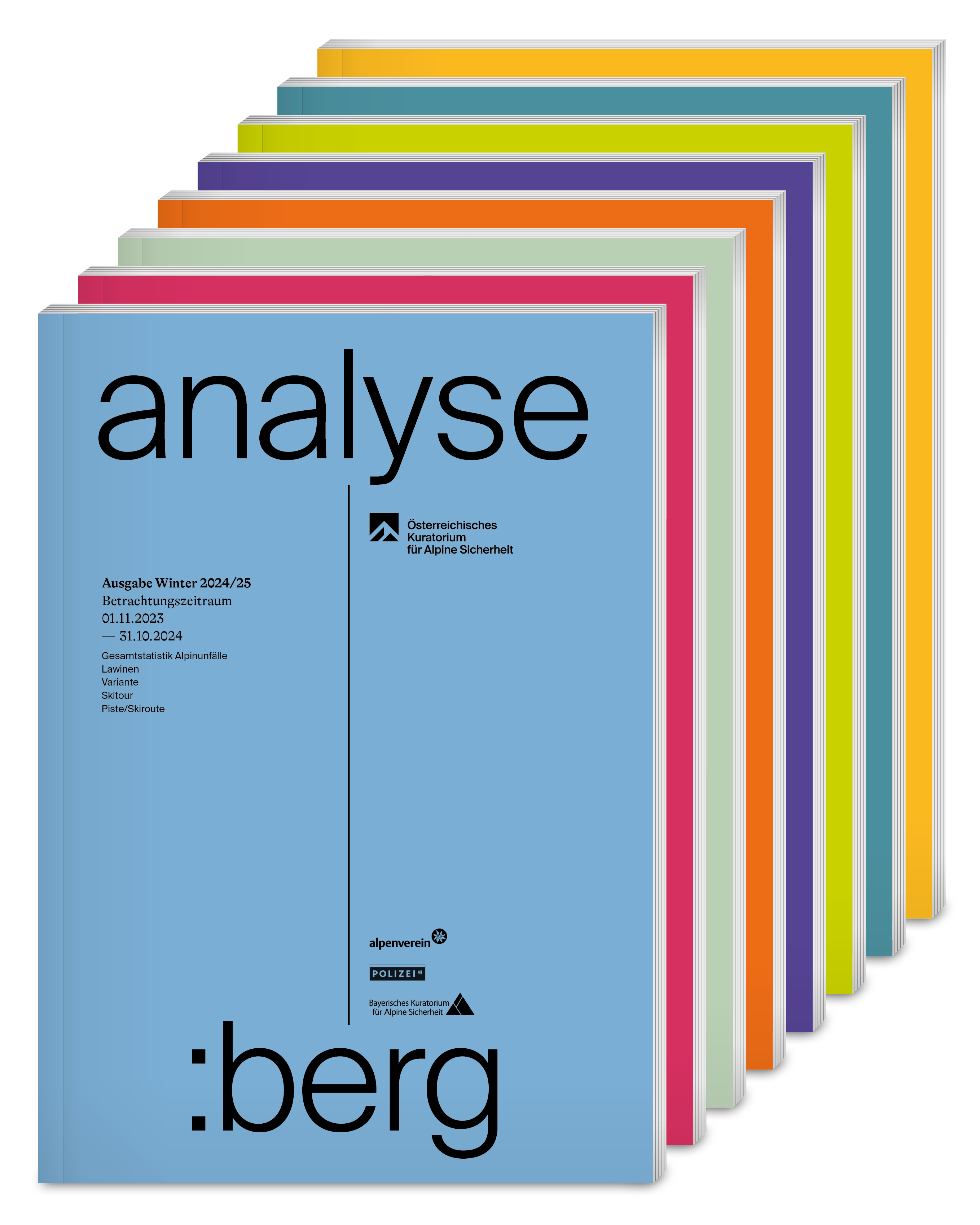
- This article is published in the ÖKAS trade magazine analyse:berg Winter 2023/24 (observation period: 01.11.2022 to 31.10.2023).
- Editor-in-chief: Peter Plattner(peter.plattner@alpinesicherheit.at)
- Subscription magazine analyse:berg Winter & Summer
- Alpine Primer Series of the Board of Trustees
- Alpine Fair / Alpine Forum 2024
- Contact ÖKAS:
Susanna Mitterer, Austrian Board of Trustees for Alpine Safety, Olympiastr. 39, 6020 Innsbruck, susanna.mitterer@alpinesicherheit.atTel. +43 512 365451-13

